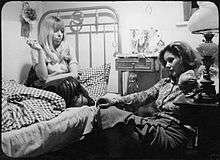The Living Truth
| The Living Truth | |
|---|---|
 DVD cover | |
| Croatian | Živa istina |
| Directed by | Tomislav Radić[1] |
| Produced by | Kruno Heidler[2] |
| Screenplay by | Tomislav Radić[1] |
| Starring |
|
| Music by | Arsen Dedić[2] |
| Cinematography | Dragutin Novak[1] |
| Edited by | Maja Filjak-Bilandžija[1] |
Production companies | |
Release dates |
|
Running time | 77 minutes[1] |
| Country | Yugoslavia |
| Language | Croatian |
The Living Truth (Živa istina), also released as Real Truth,[4] is a 1972 Croatian film directed and written by Tomislav Radić, starring Božidarka Frajt.
Radić's directorial debut, a very low-budget cinéma vérité-style film about the everyday life of a struggling actress was met with critical acclaim and is considered one of the best Croatian films of the 1970s.[1] It started the career of Božidarka Frajt, whose performance won the Golden Arena for Best Actress at the 1972 Pula Film Festival.
Plot
Božidarka Frajt (playing herself[1]) is an actress who is unsuccessfully looking for a job in Zagreb. The film follows her everyday life: she spends time with her friends and colleagues, shoots a television commercial, goes to a party, remembers her difficult childhood as a war orphan, and contemplates her professional and personal failures.[1][3][5]
Background
Before his feature film debut, Tomislav Radić, an accomplished theatre director, had gained some filmmaking experience while shooting documentaries about people with unusual occupations for Radiotelevision Zagreb. Radić had an idea to make a cinéma vérité-style film based on the life and personality of Božidarka Frajt, then a 30-year-old actress who, despite holding an acting diploma, was unable to find permanent employment, being constrained to minor film roles and occasional modeling work.[5] Instead of making a documentary about her, he would make a feature film about a woman very much like her, and the other participants would play themselves, likewise appearing under their own names.[1][3][5]
Production
The film was shot in the first half of 1971,[2] over nine working days,[5] in ultra-low budget conditions, using 16 mm black-and-white film which was later transferred to 35 mm format.[1] Framing and camera movement were not planned in advance; instead, the decisions were made on the spot, in agreement between the cinematographer Dragutin Novak and the director.[5]
Analysis
Croatian film critic Nenad Polimac argued that the film was not actually meant to be cinéma vérité, and could not be properly described as such. According to him, the very idea of actors playing themselves was radically different from anything that could be seen in the cinema of the era. Also, instead of preserving the continuity of the footage, Radić broke the scenes into short fragments that were interspersed throughout the film, creating a more dynamic slice-of-life feel and structure.[3][5] The editing was sometimes deliberately crude, with abrupt cuts. The "dirty" aesthetics of the film was thus a mix of extreme realism and extreme artificiality.[5]
Reception and legacy
The film's gritty, naturalist character came as a shock to many contemporary viewers,[5] but most critics received it very positively.[3] Still, the political establishment was disapproving: The Living Truth was characterized as an "unrepresentative depiction of the social scene" and received the permit for public screening only after a lengthy delay.[3]
The film was shown in the out-of-competition section of the 1972 Pula Film Festival, which caused protests from the critics.[1] In the end, the festival jury – presided by Stipe Šuvar – made an unprecedented decision to award Golden Arena for Best Actress to Božidarka Frajt, contrary to the festival's regulations.[1][3][5] Frajt's highly dynamic, dominant personality offset the otherwise depressing setting of the film, and her performance instantly made her one the leading actresses of Croatian and Yugoslav cinema.[3][5]
In a 1999 poll among 44 Croatian film critics and film historians, The Living Truth placed 20th in the list of all-time best Croatian films.[6]
The film was photochemically restored in 1998, digitally restored in 2009, and released on DVD in 2010.[2][4]
References
- 1 2 3 4 5 6 7 8 9 10 11 12 13 14 "Živa istina". hrfilm.hr (in Croatian). Croatian Film Association. Retrieved 2016-08-14.
- 1 2 3 4 Heidl, Janko (28 February 2011). "I danas svježe ostvarenje". filmovi.hr (in Croatian). Retrieved 2014-12-03.
- 1 2 3 4 5 6 7 8 9 Peterlić, Ante (2008). "Živa istina". Filmski leksikon (in Croatian). Zagreb: Miroslav Krleža Institute of Lexicography. Retrieved 2014-12-01.
- 1 2 "#08 Real Truth". hfs.hr. Croatian Film Association. Retrieved 2015-12-09.
- 1 2 3 4 5 6 7 8 9 10 11 Polimac, Nenad (2010). "Film koji je probudio hrvatsku kinematografiju" [The film that woke up the Croatian cinema]. Zapis (in Croatian). Croatian Film Association (68). Retrieved 2014-12-01.
- ↑ ""Tko pjeva, zlo ne misli" najbolji hrvatski film svih vremena!". Slobodna Dalmacija (in Croatian). 28 November 1999. Retrieved 2013-02-08.
Further reading
- Gilić, Nikica (2014). "Rane 1970-e i filmski slučaj Tomislava Radića" [Early 1970s and the Cinematic Case of Tomislav Radić] (PDF). Poznańskie Studia Slawistyczne (in Croatian) (6): 91–103. Retrieved 14 December 2014.
- Polimac, Nenad (1 December 2008). "Tomislav Radić: Kako pobijediti naše licemjerje". jutarnji.hr (in Croatian). Archived from the original on 17 November 2015. Retrieved 15 November 2015.
- "Živa istina (komad)". arhinet.arhiv.hr (in Croatian). Zagreb: Croatian State Archives. Retrieved 12 February 2016.
- "Istina o Živoj istini" [The Truth About The Living Truth]. Zapis (in Croatian). Croatian Film Association (72). 2011. Retrieved 14 August 2016.
- Hrabrost ratnika
- Matica bi trebala osnovati televiziju
